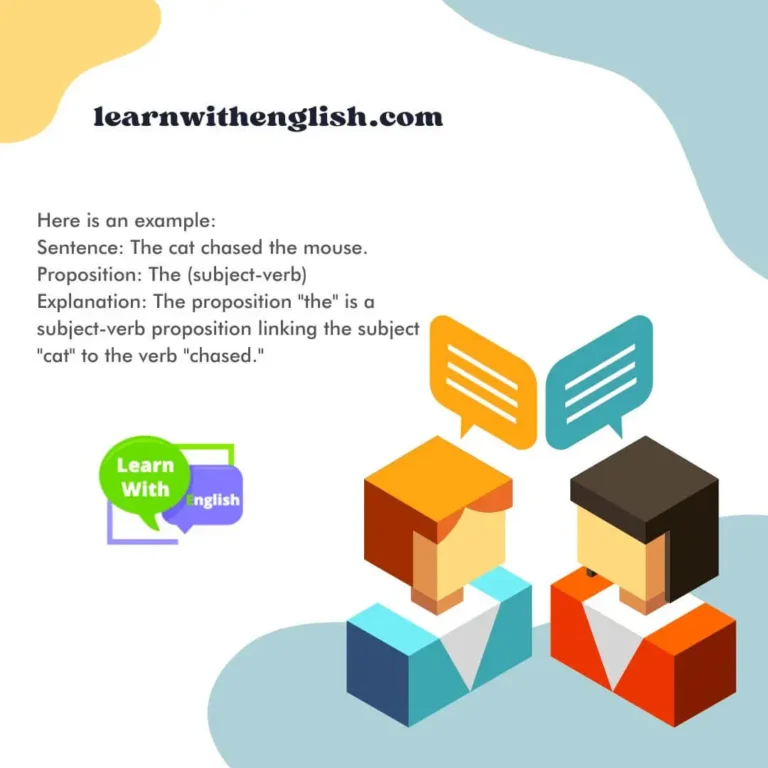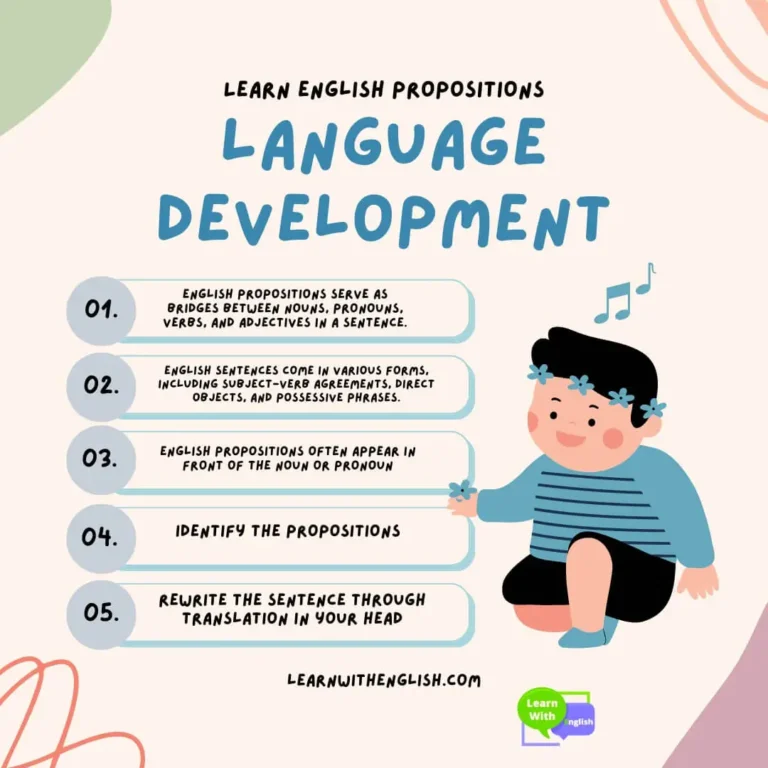Do you ever feel lost in an English conversation, unable to comprehend the propositions being spoken?
Or maybe disgruntled while trying to articulate your thoughts accurately, not quite sure how to use these same propositions correctly?
Worry not – we all struggle with this. Propositions are a major component of the English language and can be tricky at times; however, if mastered they will undoubtedly improve your communication abilities tremendously.
This article is a guide to English propositions, designed specifically for language learners. We’ll cover why these are fundamental components of mastering the English language and how you can refine your understanding through practical tips and exercises. With our help, you will be able to communicate with ease in any situation!
Ready to become an English propositions master? With this article, you’ll be able to reach your goal in no time. So let’s jump right into it!
What are English Propositions?
English propositions serve as bridges between nouns, pronouns, verbs, and adjectives in a sentence. They are integral to conveying an understanding of the relationships among these elements within a sentence – making it crystal clear what role each noun or pronoun plays.
English sentences come in various forms, including subject-verb agreements, direct objects, and possessive phrases.
Subject-verb propositions serve to connect the subject of a sentence with its respective verb; for instance, in “The cat chased the mouse,” the word “the” functions as an intermediary between both components.
To link the object of a verb to its corresponding action, we use Object Propositions. For instance, in “the mouse chased,” “mouse” is that which gets pursued and the word “the” binds it to the verb ‘chased.’
Possessive propositions are a great way to show that something belongs to somebody or something. For example, in the phrase “The cat’s toy is missing,” the possessive proposition “cat’s” tells us that the object of discussion -the toy- belongs to the said feline.
To thoroughly comprehend the English language, it is essential to have a thorough grasp of how these different types of terms are utilized in sentences.
This knowledge can alter or modify both the meaning and syntax of a sentence. Let’s take an even closer look at some illustrations so we can develop a better understanding through practice.
Subject-verb propositions:
- “She sings in the choir.” (The subject-verb proposition “she” links the subject “She” to the verb “sings.”)
- “They are going to the store.” (The subject-verb proposition “they” links the subject “they” to the verb “are going.”)
Object propositions:
- “I gave the book to him.” (The object proposition “to” links the object “book” to the verb “gave.”)
- “She showed the picture to her friends.” (The object proposition “to” links the object “picture” to the verb “showed.”)
Possessive propositions:
- “His car is new.” (The possessive proposition “his” indicates that the car belongs to him.)
- “The dog’s toy is chewed up.” (The possessive proposition “dog’s” indicates that the toy belongs to the dog.)
Complex propositions
A complex Proposition is a proposition that contains multi-word statements that vividly communicate information and context. They can be used as the subject, object, or predicate of a sentence, further enhancing the clarity with which ideas are grasped by readers.
Here are a few examples of complex propositions:
- “The fact that she was late to the meeting was surprising.” (The complex proposition “that she was late to the meeting” is the object of the verb “was.”)
- “The idea that we should go on vacation is appealing.” (The complex proposition “that we should go on vacation” is the subject of the verb “is.”)
- “The reason he didn’t come to the party is that he was sick.” (The complex proposition “that he didn’t come to the party” is the predicate of the sentence, and the complex proposition “because he was sick” explains the reason.)
Complex prepositions are a critical part of the English language, allowing us to express more nuanced and sophisticated thoughts. They add detail, depth, and context to sentences – enriching our conversations with greater clarity. As such, it pays to be familiar with complex propositions so that we can communicate effectively in any situation!
Tips for understanding English propositions
Knowledge of English propositions is paramount for precise comprehension and construction of sentences in English. To assist you, our next section offers helpful advice on how to boost your understanding of these fundamental language components!
To further your comprehension of the English language, let’s delve into a few strategies to refine your understanding of propositions. One noteworthy action is recognizing sentence structure.
Observe how different phrases are combined and study the relationships between them. Additionally, try forming sentences yourself and reflecting on how they could be improved or revised for clarity.
With these techniques, you can become an expert in crafting grammatically correct declarations!
English propositions often appear in front of the noun or pronoun and usually differ according to their function.
To illustrate, subject-verb propositions are generally expressed in the nominative case while object ones occur more frequently in accusative and dative cases.
Being conscious of a proposition’s place and form can help you grasp its role within a sentence better.
Another useful tactic for an English learner is to search for words or phrases that can help you recognize the proposition and its purpose in the sentence.
Try searching for verbs and their subjects/objects, as well as possessive adjectives and pronouns that indicate ownership. With this approach, you’ll be able to effectively identify propositions!
Verb tense plays an important role in providing insight into the context and relationships of a sentence.
For instance, when verbs are rendered in the present tense, it implies that they’re taking place currently; yet if they appear in the past tense, then you can infer that those activities have already been realized.
Thus, being mindful of verb tenses provides clues about both timing and subject-object dynamics.
Making use of the strategies shared here and putting in the effort to construct different types of sentences can help you master English propositions with ease. With this knowledge, students will be able to interpret and produce correct English sentences confidently!

Tips for understanding English propositions
Now that you’re equipped with ways to master English propositions, it’s time to get in some practice! Immerse yourself in a few exercises and gain familiarity with recognizing and comprehending proposals within different kinds of sentences.
Doing this will build your confidence when using them appropriately, so let the learning begin!
Exercise 1: Identify the propositions
In this exercise, you will be given a series of sentences with the propositions highlighted. Your task is to identify the type of proposition (subject-verb, object, possessive) and explain its role in the sentence.
Here is an example:
Sentence: The cat chased the mouse.
Proposition: The (subject-verb)
Explanation: The proposition “the” is a subject-verb proposition linking the subject “cat” to the verb “chased.”
Exercise 2: Complete the sentence
In this exercise, you will be given a series of incomplete sentences and a list of words to choose from. Your task is to select the correct proposition and insert it into the sentence to complete it.
Here is an example:
Incomplete example sentence: The cat _____ the mouse.
Options: chased, chased the
Correct proposition: chased
Explanation: The correct proposition is “chased,” as it is the verb of the sentence and links the subject “cat” to the object “mouse.”
Exercise 3: Rewrite the sentence
In this exercise, you will be given a series of sentences and asked to rewrite them using a different proposition. This will help you practice using different types of propositions and understand how they can change the meaning of a sentence.
Here is an example:
Original sentence: The cat chased the mouse.
Rewritten sentence: The mouse was chased by the cat.
Explanation: The rewritten sentence uses the preposition “by” as an object proposition, linking the object “mouse” to the verb “was chased.”
Challenge yourself to push your limits by trying out various practice exercises. Remember, making mistakes is simply part of the journey and nothing to be afraid of! With dedication and consistent effort, you’ll soon become a pro at using English propositions in no time.
Practice exercises for mastering English propositions
This is an extra practice to help you understand and use English propositions.
Exercise 4: Create your sentences
In this exercise, you will create your sentences using a variety of propositions. This will help you practice using different types of propositions and understand how they can affect the meaning of a sentence.
Here is an example:
Original sentence: The student handed in the homework to the teacher.
Rewritten sentence: The teacher received the homework from the student.
Explanation: The rewritten sentence uses the preposition “from” as an object proposition, linking the object “homework” to the verb “received.” It also uses the subject-verb proposition “the” to link the subject “teacher” to the verb “received.”
To complete this exercise, try creating your sentences using different types of propositions. You can use the examples above as a guide, or come up with your scenarios.
For example, you might create a sentence about a person giving a gift to a friend (using a possessive proposition), or a sentence about a person buying a ticket to a concert (using an object proposition).
The more you practice creating sentences with different types of propositions, the more comfortable you will become with using them in your communication.
I hope these exercises help improve your understanding and use of English propositions. With time and practice, you’ll be able to confidently use these important language elements to communicate effectively in English.
Conclusion
In this article, we’ve unearthed the value of English propositions and offered advice and exercises to sharpen your grasp of these fundamental language components.
We’ve outlined the meaning of English propositions, discussed their usage in diverse types of sentences, and presented techniques to identify them quickly. To assist you with becoming an expert on English propositions and using them accurately and confidently, we’ve included various practice challenges.
Beginner-level English proposition skills can quickly and easily be transformed into expert proficiency with the following tips and exercises! To improve your understanding of this subject even further, continue to practice daily.
Look for additional resources as well as engage in an online course or get one-on-one tutoring sessions with a native speaker that will help you reach any goals you have set for yourself. With such steps taken, your expertise in English propositions is only moments away!
Put yourself to the task and you’ll soon have absolute assurance speaking English propositions in any circumstance, augmenting your communication skills and broadening your lexicon.
Don’t forget that all missteps are chances for growth, so don’t be discouraged by them. Best of luck on this amazing adventure!


